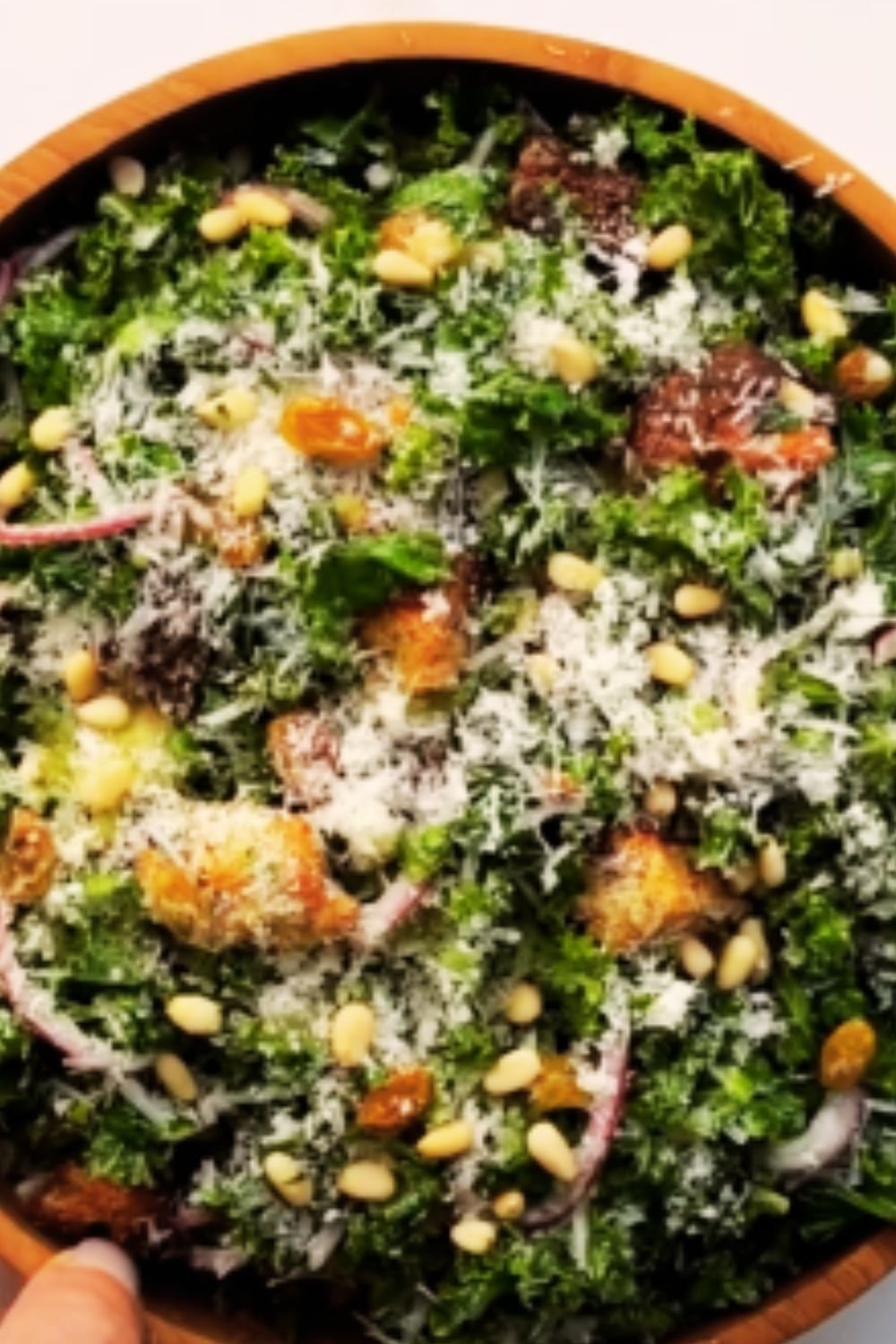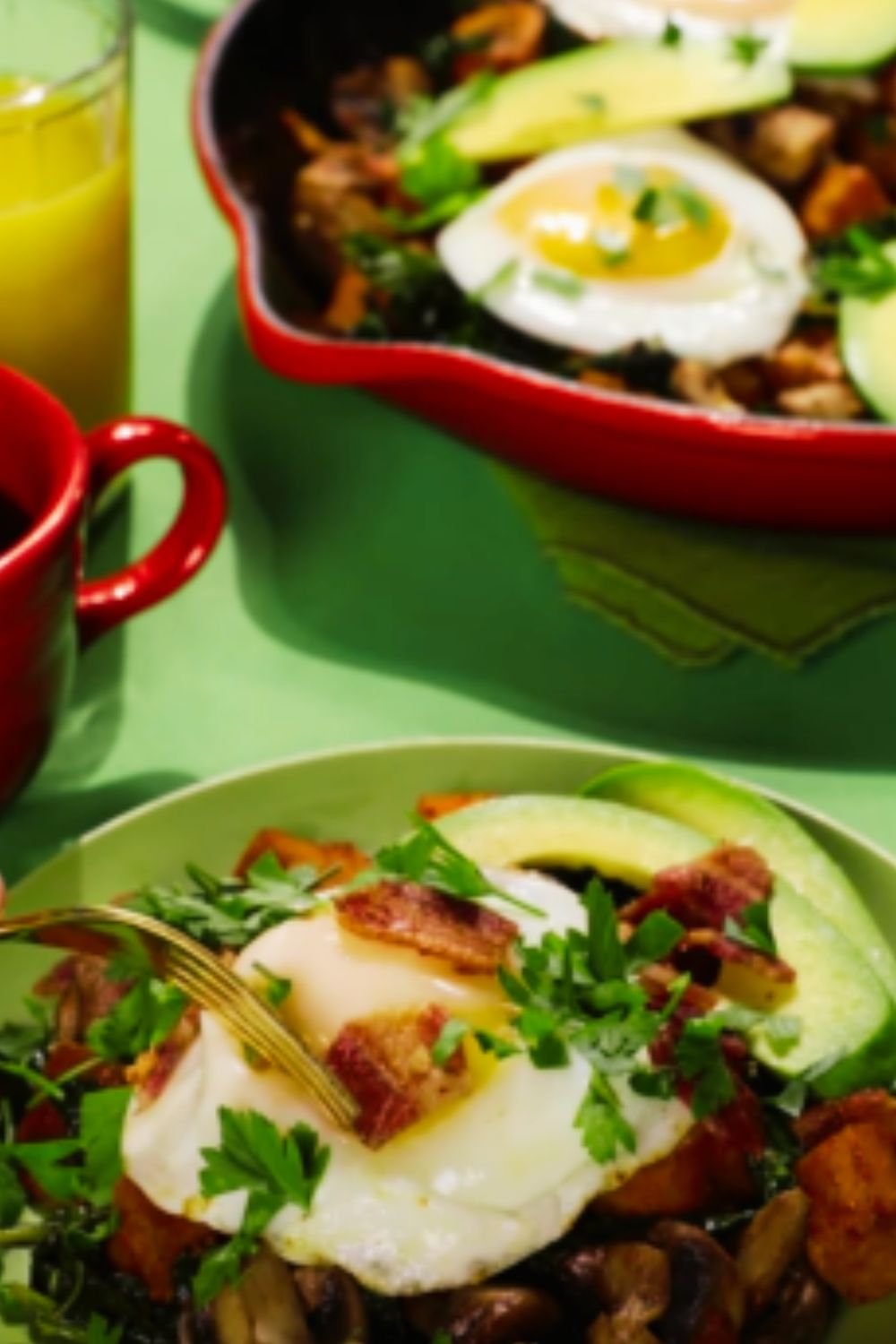There’s something magical about a perfectly prepared kale salad that transforms this humble leafy green from a tough health food into a crave-worthy dish. I’ve spent years perfecting my kale salad recipe, and today I’m sharing my ultimate version featuring a honey dijon dressing that will make even the most dedicated kale skeptics ask for seconds.
What sets this kale salad apart isn’t just the zingy honey dijon dressing (though it’s certainly a star), but the technique of massaging the kale leaves until they’re tender and silky. This crucial step breaks down the fibrous texture that gives raw kale its reputation for being difficult to enjoy. Trust me – I was once a kale doubter myself until I discovered this game-changing approach!
The Magic of Massaged Kale
Before we dive into the recipe, let’s talk about why massaging kale transforms it so dramatically. Kale leaves are naturally tough and fibrous – nature designed them that way to protect the plant. When you massage kale with a bit of oil, salt, and acid (like lemon juice), you’re essentially beginning the breakdown of those tough fibers. This mechanical action does what cooking would do, but without the heat, preserving all the nutritional benefits of raw kale while creating a much more pleasant eating experience.
I first learned this technique at a cooking class years ago, and it completely revolutionized my relationship with kale. The first time I tried it, I couldn’t believe the transformation – from tough, bitter leaves to silky, flavorful greens in just a few minutes of hands-on work.
Why This Kale Salad Recipe Works
This isn’t just any kale salad – it’s a carefully balanced combination of flavors and textures that work harmoniously together:
- Massage technique: Breaks down tough fibers for a tender, silky texture
- Sweet-tangy dressing: The honey dijon dressing offers the perfect balance of sweetness, acidity, and creaminess
- Textural contrast: Crunchy seeds, nuts, and crisp apple complement the tender kale
- Make-ahead friendly: Unlike many salads, this one actually improves if made a few hours ahead
- Nutritional powerhouse: Delivers an impressive array of nutrients in a delicious package
Ingredients You’ll Need
For the best kale salad, quality ingredients make all the difference:
For the Salad Base:
- 2 large bunches curly kale (about 10-12 cups once prepped)
- 2 tablespoons extra virgin olive oil (for massaging)
- 1/4 teaspoon sea salt (for massaging)
- 1 tablespoon fresh lemon juice (for massaging)
- 1 medium apple, cored and thinly sliced
- 1/3 cup dried cranberries
- 1/3 cup pumpkin seeds
- 1/4 cup sliced almonds, toasted
- 1/3 cup shaved Parmesan cheese
For the Honey Dijon Dressing:
- 3 tablespoons extra virgin olive oil
- 2 tablespoons apple cider vinegar
- 1 tablespoon Dijon mustard
- 1 tablespoon honey
- 1 small garlic clove, minced
- 1/4 teaspoon sea salt
- Freshly ground black pepper to taste
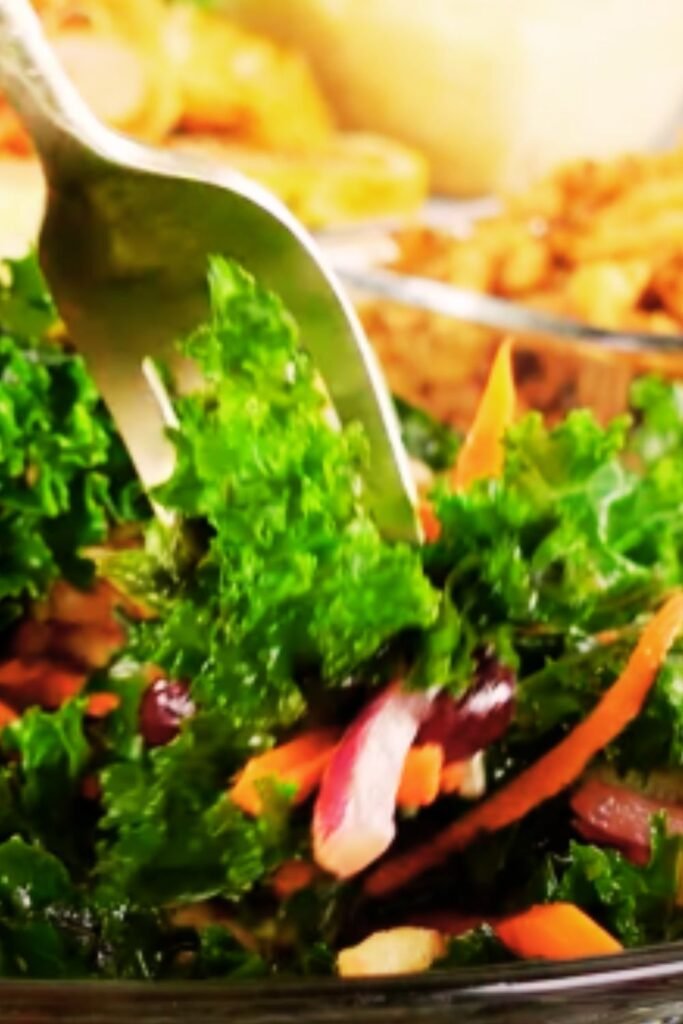
Nutritional Profile
Before we get to the preparation, let’s take a look at why kale is such a nutritional powerhouse:
| Nutrient | Amount per 100g | Benefits |
|---|---|---|
| Vitamin K | 817% of RDI | Supports bone health and blood clotting |
| Vitamin A | 206% of RDI | Essential for vision, immune function, and cell growth |
| Vitamin C | 134% of RDI | Supports immune function and collagen production |
| Manganese | 26% of RDI | Supports metabolism and bone formation |
| Calcium | 9% of RDI | Supports bone health and muscle function |
| Potassium | 8% of RDI | Helps maintain healthy blood pressure |
| Fiber | 3.6g | Supports digestive health and helps maintain fullness |
| Protein | 2.9g | Supports muscle maintenance and growth |
RDI = Recommended Daily Intake
Step-by-Step Instructions
Preparing the Kale
- Wash and dry the kale thoroughly. I like to use a salad spinner to ensure it’s completely dry.
- Remove the stems by holding the end of the stem in one hand and pulling the leaves away with your other hand. The stems are too tough for a raw salad.
- Tear or chop the kale leaves into bite-sized pieces and place them in a large mixing bowl.
- Add the massaging ingredients to the bowl: 2 tablespoons olive oil, 1/4 teaspoon salt, and 1 tablespoon lemon juice.
- Massage the kale with your hands for 3-5 minutes. Don’t rush this step! I like to grab handfuls and literally massage it, feeling the leaves become softer and silkier as I work. You’ll notice the kale will turn a deeper green and reduce in volume by almost half.
Making the Honey Dijon Dressing
- Combine all dressing ingredients in a jar with a tight-fitting lid: olive oil, apple cider vinegar, Dijon mustard, honey, minced garlic, salt, and pepper.
- Shake vigorously until well combined and emulsified. This should take about 30 seconds of good shaking.
- Taste and adjust seasoning if needed. If it’s too tangy, add a bit more honey. If too sweet, add a splash more vinegar.
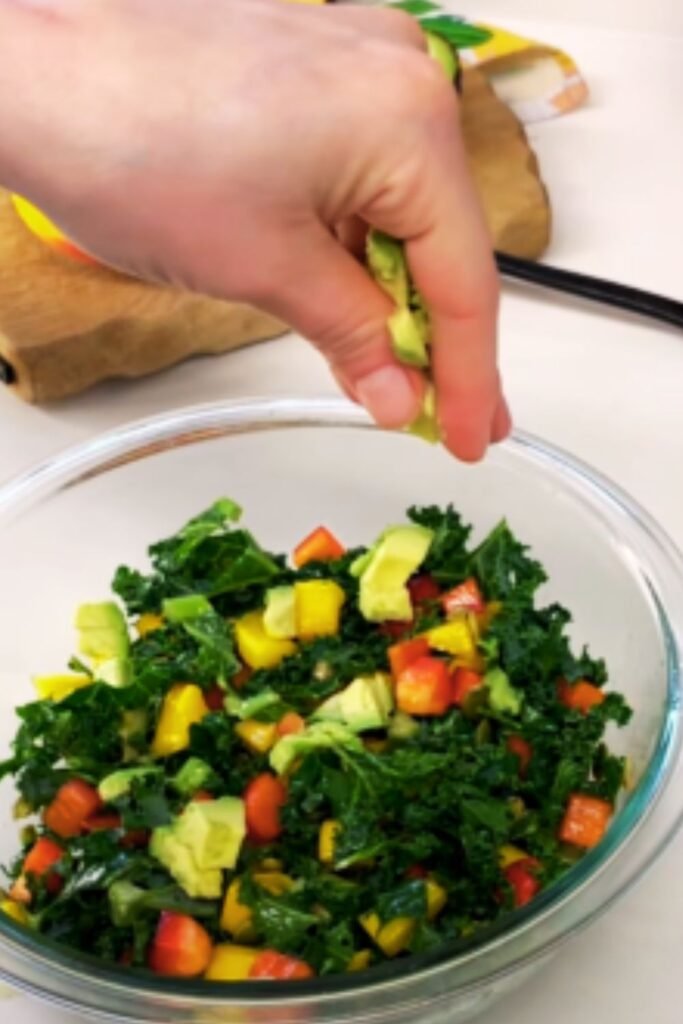
Assembling the Salad
- Pour about half the dressing over the massaged kale and toss well to coat all the leaves.
- Add the apple slices, dried cranberries, and pumpkin seeds to the bowl and toss gently to distribute.
- Sprinkle the toasted almonds and shaved Parmesan over the top of the salad.
- Drizzle the remaining dressing over the salad or serve it on the side for people to add as desired.
Tips for the Perfect Kale Salad
I’ve made this salad countless times, and here are some tips I’ve learned along the way:
- Don’t skip the massage: This is absolutely crucial for the texture of the salad.
- Make ahead: This salad actually improves if it sits for 30 minutes to 4 hours in the refrigerator after dressing.
- Kale varieties: Curly kale works best for this salad, but lacinato (dinosaur) kale can be substituted. Red kale tends to be tougher and requires more massaging.
- Dressing consistency: If your honey is thick, warm it slightly before mixing to help it incorporate more easily.
- Toasting nuts: Always toast nuts and seeds to enhance their flavor. I do this in a dry skillet over medium heat for 3-5 minutes, stirring frequently.
- Cheese alternatives: If you don’t eat dairy, nutritional yeast makes a great substitute for the Parmesan.
Variations to Try
While I love this classic version, I often mix things up depending on what’s in season or in my pantry:
Seasonal Variations:
- Summer: Add peaches and blueberries, substitute feta for Parmesan
- Fall: Add roasted butternut squash and pomegranate seeds
- Winter: Add roasted beets and oranges segments
- Spring: Add strawberries and goat cheese
Dietary Variations:
- Vegan: Skip the Parmesan or use nutritional yeast instead; use maple syrup instead of honey
- Nut-free: Skip the almonds and add more pumpkin seeds or sunflower seeds
- Grain boost: Add 1 cup of cooked quinoa or farro for a heartier salad
- Protein boost: Add a cup of chickpeas or white beans, or top with grilled chicken
Storage and Make-Ahead Tips
Unlike most salads that wilt quickly once dressed, kale salad can be prepared in advance:
- Dress up to 4 hours ahead: The salad will only get better as the dressing continues to tenderize the kale.
- Store leftovers: Will keep well in an airtight container in the refrigerator for up to 2 days.
- Prep components separately: If making for meal prep, keep the dressing, kale base, and toppings separate and assemble when ready to eat.
Serving Suggestions
This versatile salad works beautifully as a side dish or can be transformed into a main course:
- As a side: Pair with grilled salmon, roasted chicken, or a hearty soup
- As a main: Add protein like grilled chicken, roasted chickpeas, or hard-boiled eggs
- For a gathering: Double the recipe and serve in a large wooden bowl for a stunning presentation
- For lunch: Pack in a container with the dressing on the bottom, kale next, and toppings on top; shake when ready to eat
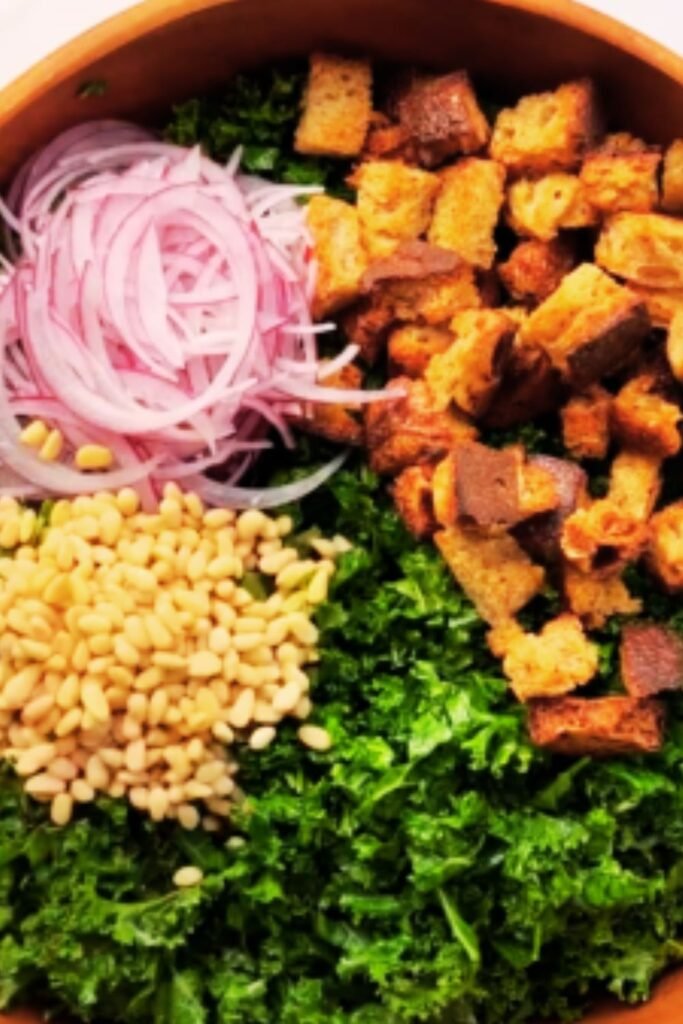
Seasonal Ingredient Substitutions Table
| Ingredient | Spring | Summer | Fall | Winter |
|---|---|---|---|---|
| Fruit | Strawberries | Peaches or Blueberries | Apples or Pears | Oranges or Grapefruit |
| Nuts/Seeds | Walnuts | Sliced Almonds | Pecans | Hazelnuts |
| Cheese | Goat Cheese | Feta | Aged Cheddar | Blue Cheese |
| Add-ins | Asparagus | Fresh Corn | Roasted Squash | Roasted Root Vegetables |
| Herbs | Dill or Mint | Basil | Sage | Thyme |
The Science Behind Massaging Kale
I find the transformation of kale through massaging fascinating. Here’s what actually happens:
When you massage kale with salt, oil, and acid (like lemon juice), you’re breaking down the tough cell structure that gives raw kale its fibrous texture. The salt helps draw out moisture, the acid begins to denature proteins, and the mechanical action of massaging physically breaks down cell walls. This process is similar to what happens when you cook kale, but without heat.
The result is a partially “pre-digested” kale that’s not only more pleasant to eat but potentially more nutritious as some of the nutrients become more bioavailable. This technique transforms kale from a tough, somewhat bitter green into a tender, flavor-absorbing base for a delicious salad.
Frequently Asked Questions
Q: Why is my kale still tough even after massaging? A: You might need to massage it longer or more vigorously. Make sure you’re using enough olive oil and salt, which help break down the fibers. Also, some varieties of kale are naturally tougher than others – curly kale generally works best for salads.
Q: Can I make this salad ahead of time? A: Absolutely! Unlike most salads, kale salad actually improves if made a few hours ahead. The dressing continues to tenderize the kale, making it even more delicious. Just add the nuts right before serving to maintain their crunch.
Q: What can I substitute for honey to make this vegan? A: Maple syrup works beautifully as a substitute for honey in the dressing, with almost no difference in taste. Agave nectar is another good option.
Q: How do I know when I’ve massaged the kale enough? A: The kale should reduce in volume by almost half, turn a deeper green color, and feel silky rather than rough. Take a small piece and taste it – it should be tender and not difficult to chew.
Q: Can I use a different type of kale? A: Yes! While curly kale is my favorite for this salad, lacinato (dinosaur) kale also works well. Red kale tends to be a bit tougher and may need more massaging. Baby kale needs very little or no massaging at all.
Q: My family doesn’t like kale. How can I make this more appealing to kale skeptics? A: The massaging technique and sweet-tangy dressing go a long way in making kale more appealing. You can also try adding more sweet elements like additional fruit or a bit more honey in the dressing. Starting with a kale blend (half kale, half romaine or spinach) can also help transition kale skeptics.
Q: How long does the dressing keep? A: The honey dijon dressing will keep well in an airtight container in the refrigerator for up to 2 weeks. Just shake well before using as it will separate naturally.
My Personal Journey with Kale
I wasn’t always a kale enthusiast. In fact, my first experiences with it were less than impressive – tough, bitter salads that felt more like punishment than pleasure. It wasn’t until I learned about massaging kale that everything changed.
I remember the first time I made this salad for friends. They approached it with skepticism (as most people do when faced with a big bowl of kale), but after one bite, the conversation stopped and was replaced with appreciative murmurs. By the end of the night, everyone had asked for the recipe.
What I love most about this salad is its versatility and how it brings together so many wonderful elements – the slight bitterness of the kale balanced by the sweet-tangy dressing, the crunch of seeds and nuts, the chewy dried fruits, and the savory notes from the cheese. It’s a symphony of flavors and textures that proves healthy eating doesn’t have to be bland or boring.
Whether you’re a long-time kale lover or a skeptic willing to give it one more chance, I hope this recipe changes your relationship with this incredible superfood. Give it a try, and you might just find yourself craving kale – something I never thought I’d say!
